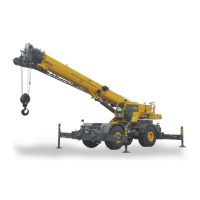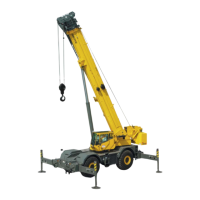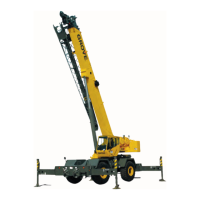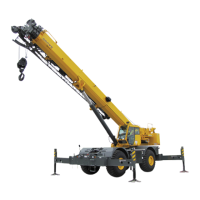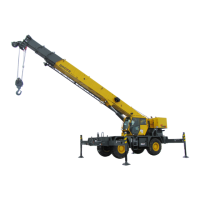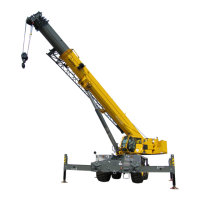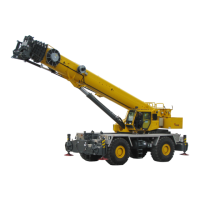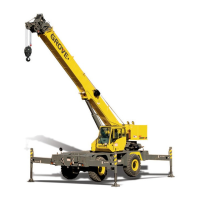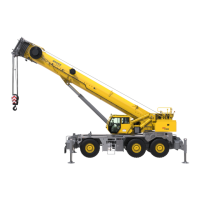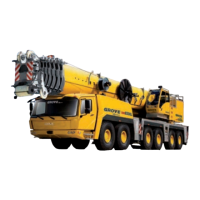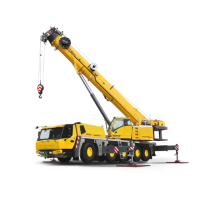BOOM RT765E-2 SERVICE MANUAL
4-32
Published 9-04-2014, Control # 422-08
Swingaway Mounting Adjustment
The following procedures may be used to adjust the existing
installation or for installing a new swingaway and/or stinger.
For the referenced details in text, refer to (Figure 4-5).
1. With the swingaway base laying on the ground or
cribbing, use an adequate lifting device to place the
stinger on the side of the base and install the one attach
pin.
2. Raise the sheave end of the stinger until the attach pin
installed in step 1 is loose. Install the ramp wear pad
(Figure 4-5) (Detail C) on the bottom of the stinger and
shim to provide a clearance of 12 mm (0.5 in) between
wear pad and ramp on swingaway base.
3. Install the shock wear pad (Figure 4-5) (Detail C) on the
extension base bracket. Shim the wear pad to provide a
clearance of 3 mm (1/8 in) between shock wear pad and
ramp wear pad installed in step 2.
4. With the stinger supported on the base ramp wear pad
and held tight against the shock wear pad, adjust the
stinger latch hook (Figure 4-5) (Detail E) so that a 4 mm
(5/32 in) clearance is maintained between the hook and
the latch bar.
5. Remove the stinger from the side of the extension base.
6. Disengage the boom stop and fully retract the boom.
7. Mount the extension base of the right side on the boom
base and install the pins attaching the extension base to
the boom nose.
8. Loosen the front and rear stowage bracket attaching
hardware.
9. Lift the sheave end of the extension base until the
attachment pins installed in step 7 are loose. Refer to
(Figure 4-5) (Detail D) (rear stowage bracket) and adjust
the lower mount and the pin mount to maintain a loose
condition of the attachment pins. Tighten all rear
stowage bracket attaching hardware.
10. Refer to (Figure 4-5) (Detail A) (front stowage bracket)
and adjust the main hanger, upper hanger, and lower
support to maintain a loose condition of the attachment
pins.
11. Move the extension base away from the boom base and
mount the stinger on the extension base using one
attach pin. Position extension base on stowage brackets
on side of boom.
12. Lift up on sheave end of stinger until attachment pin is
loose and stinger is 3 mm (1/8 in) from shock wear pad
at the ramp (Figure 4-5) (Detail C).
13. Refer to detail B (stinger front stowage bracket) and
adjust the front mount and hanger to maintain the
attachment pin in a loose condition.
14. Refer to (Figure 4-5) (Detail D) (rear stowage bracket)
and adjust the stinger upper hanger and lower hanger to
maintain the attachment pin in a loose condition.
15. Some final adjustment of the stinger latch may be
required. With the extension base and stinger in the final
stowed position on the stowage brackets, ensure there
is approximately a 3 mm (1/8 in) clearance between the
shock wear pad and the ramp wear pad on the stinger
(Figure 4-5) (Detail C). In addition, the stinger latch must
be free (approximately a 1.5 mm (0.06 in) clearance
between the surfaces of the latch hook and the latch
bar.Hook Block
Description
A 65 ton (60 metric ton) hook block and a 8.3 ton (7.5 metric
ton) overhaul top swivel ball are available for the crane. The
hook block utilizes a one-piece pivot block and the hook is
equipped with a safety latch. The hook block is of quick-
reeve design and meets ANSI B30.5 and CE standards. The
hook block weighs 1275 lb (580 kg). Grease fittings are
provided to ensure lubrication of all moving parts.
Maintenance
Periodic Maintenance
It is recommended that the hook block and/or headache ball
be inspected every 50 hours. A complete disassembly
inspection should be conducted every quarter or 500 hours
in the area of the hook, hex nut, and threaded areas for
corrosion and proper fit. After assembly of the hook, a liberal
coating of multipurpose grease should be applied to the nut
and threaded areas by brush or hand to prevent corrosion.
For hook blocks and other load handling devices not
manufactured by Grove; follow the manufacturer’s
inspection and testing recommendations to assure an
adequate preventative maintenance program is established.
Reference Only

